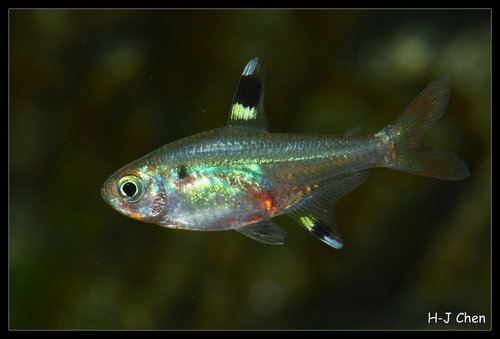
X-ray Tetra
The Atlantic bluefin tuna (Thunnus thynnus) is a highly migratory, large pelagic fish renowned for its size, speed, and commercial value. It is a top predator in the marine ecosystem, playing a crucial role in maintaining balance. The species faces significant conservation challenges.
3 5 years
Lifespan
4.5 cm
Length
Least Concern
Conservation Status
N/A km/h
Swimming speed
Insectivorous
Diet
Local Migration
Migration
Appearance Overview
The Atlantic bluefin tuna is a large, streamlined fish with a metallic blue body and a silvery-white belly.
Coloration
Dark metallic blue on top, silvery-white underside
Body Shape
Torpedo-shaped, built for speed and endurance
Fins
Two dorsal fins, the first depressible; small finlets behind dorsal and anal fins
Keel
Strong lateral keel on the caudal peduncle
Length
Up to 13 feet (4 meters), commonly around 6.5 feet (2 meters)
Weight
Up to 2,000 lbs (900 kg), commonly around 550 lbs (250 kg)
Diet
Carnivorous, feeding on a variety of fish (such as herring, mackerel, and bluefish), squid, and crustaceans.
Feeding Behavior
Highly active predator, using its speed and agility to hunt. Often hunts cooperatively, herding prey into tight formations.
Social Behavior
Forms large schools, especially during migration and spawning. Schools may be segregated by size.
Commercial Relevance
Extremely high value, especially in the Japanese sushi and sashimi market, where a single fish can fetch hundreds of thousands of dollars.
Conservation measures
Subject to international fishing quotas and regulations managed by organizations like ICCAT. Marine protected areas and fishing gear restrictions are also in place.
Status
Endangered (IUCN)
Threats
Overfishing (historically and continuing), bycatch in fishing gear, habitat degradation, and climate change affecting prey distribution.
Habitat Distribution
Depth Range
0-1,000 meters (0-3,280 feet), most commonly found in the upper 200 meters (656 feet)
Geographic Range
Western and Eastern Atlantic Ocean, Mediterranean Sea, and formerly the Black Sea.
Preferred Environment
Pelagic, open ocean environments; prefers temperate waters but can tolerate a wide range of temperatures.
Reproduction and Life Cycle
Breeding Habits
Spawns in warm waters, primarily in the Mediterranean Sea and the Gulf of Mexico. Spawning occurs from May to August.
Development Stages
Eggs are pelagic and hatch into larvae. Larvae are planktonic and develop rapidly. Juveniles grow quickly, migrating with ocean currents.
Fecundity
Highly fecund; a large female can produce up to 30 million eggs per spawning season.
Maturity Age
Reaches sexual maturity at around 4-8 years in the Mediterranean and 8-12 years in the western Atlantic.
Faqs about X-ray Tetra
How long do Atlantic bluefin tuna live?
Atlantic bluefin tuna can live up to 40 years, although this is rare due to fishing pressure.
How fast can Atlantic bluefin tuna swim?
They are among the fastest fish in the ocean, capable of bursts of speed up to 43 mph (70 km/h).
Are Atlantic bluefin tuna warm-blooded?
Yes, they are warm-blooded, maintaining a body temperature higher than the surrounding water, which helps with their speed and endurance.
What is special about their fins?
They have a unique ability to retract their dorsal fins into a groove to reduce drag when swimming at high speeds.
Where can I find Bluefin Tuna?
Atlantic bluefin tuna are found in the western and eastern Atlantic Ocean, and the Mediterranean Sea.
Why are they endangered?
The high demand for bluefin tuna in sushi and sashimi markets, combined with their slow growth and late maturity, has led to severe overfishing.
Who manages bluefin tuna populations?
ICCAT (International Commission for the Conservation of Atlantic Tunas) is the primary organization responsible for managing bluefin tuna populations.
Copyright @ Nature Style Limited. All Rights Reserved.
 English
English